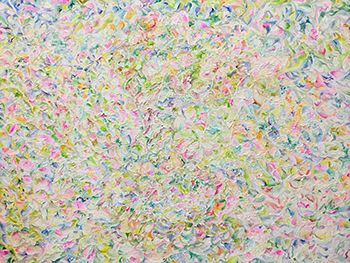
|
Kazuya Sakamoto: Spring ephemeral2020 3.6 - 4.7Opening reception: March 6th (fri.) 18:00 – 20:00 Kazuya Sakamoto’s solo show “Spring ephemeral” will conclude as of today, April 7th (tue.). |
| ©Kazuya Sakamoto |

Venue: nca | nichido contemporary art
Date: March 6th (fri.) – April 7th (tue.)
Opening hours: Tue. ~ Sat. 11:00 – 19:00 (Closed on Sunday, Monday and National holidays)
Opening reception: March 6th (fri.) 18:00 – 20:00
nca | nichido contemporary art is pleased to present Kazuya Sakamoto’s solo exhibition “Spring ephemeral”.
Through his interest in growing waterweeds inside water-tanks, Sakamoto has observed similarities between such ecosystems and today’s societies, leading him to investigate the inner side of things using plants as his motif.
The variety of species minutely represented, multiplying and breeding on the canvas, seem to be a metaphor of the constant changes required of life to thrive.
This time Sakamoto’s works investigate spring ephemerals, woodland wildflowers that bloom in the early spring for only a few weeks to disappear in summer and retreat underground. By focusing on these flowers doing their best to live and breed within their differently timed life cycle that keeps them away from struggles with other plants, Sakamoto tries to address aspects such as one’s own internal conflicts, mental state and subconscious.
Dive and rise
Starting by applying a priming coat of blue paint, Kazuya Sakamoto goes on to cover the surface of the canvas one waterweed at a time, each stroke different from the other, creating layers of a multitude of green shades with only one brush.
Waterweeds growing in aquariums, the subject of Sakamoto’s production over the last 10 years, evoke, figuratively speaking, the image of the oil-painted plants wearing while wrapping around the artist’s body who, immersed into the water, endures that sensation of breathlessness. It is as if Sakamoto is simultaneously facing the canvas and diving inside it. Furthermore, his very practice seems to overlap with the practice of a cartographer, reaching every corner of the canvas, while feeling his way one brushstroke after the other, meticulously checking each touch. In an instant the canvas replaces the earth surface and our perspective changes zooming out this land-art to the universe in a split second. Sakamoto’s brush keeps going, physically detaching itself from the canvas, constantly immersed between aquariums and artificial satellites, and finally, reaching the edges of the canvas, it stops.
As his new motif, Sakamoto has chosen a quiet plant that makes its appearance in early spring in the floor of deciduous broad-leaved forests. This type of plant is called spring ephemeral and stores its nutrients in its underground structures, rhizomes, bulbs and so forth, sprouting in early spring for a short blooming period, withering before long and spending the rest of its time below the ground again. As for his waterweeds series, here as well Sakamoto doesn’t want to create picture books or sample drawings. The touch, stubbornly repeated with the same brush, is clearly mimicking some sort of low-growing herbs in different shapes and colors. However, each drawing does not contribute to a morphologically faithful rendition of these herbs as it is solely devoted to the multiplication of the many piling possibilities of Sakamoto’s touch.
The minute strokes, covering the entire canvas up to its every corner as some sort of skin, give also the idea of a meticulously detailed work. If asked, Sakamoto would tell you that he has long hated charging his brushstrokes with his own feelings, all jumbled up to the point of suffocation.
Nevertheless, they are everywhere stuffed in the rhizomes and bulbs hidden, buried and immersed in the humid place beneath that very skin, which is the canvas. If we pay enough attention, we will notice them spilling from every bit of that exposed skin.
Nosediving from high altitudes down to the ground in the blink of an eye, then down into the water or underground holding his breath, and emerging again. Sakamoto’s eye and hand repeat this back-and-forth motion, however, this very procedure have turned into his style while allowing him to keep his feelings in check.
Kazuho Soeda
Curator at Aichi Prefectural Museum of Art
Kazuya Sakamoto
1985 Born in Tottori, Japan
2012 BFA, Painting, Nagoya University of Art, Aichi, Japan
2014 MFA, Contemporary Arts, Nagoya University of Art, Aichi, Japan
2017-18 Selected for the Agency for Cultural Affairs Program of Overseas Study in Taipei
Main solo exhibitions: “Symbiosis”, galerie nichido Taipei, Taipei (2018) / “Landscape gardening”, Yonago City Museum of Art, Tottori (2017) / “Between Breaths”, nca | nichido contemporary art, Tokyo (2016) / ALA Project No9” Kazuya Sakamoto", ART LAB AICHI, Aichi (2012)
Main group exhibitions: "nca new generation project – Sensing Body", nca | nichido contemporary art, Tokyo (2015) / " Fruitfulness - Contemporary Art in Toyokawa”, Toyokawa City Sakuragaoka Museum, Aichi (2015) / "Arts Challenge 2015", Aichi Arts Center, Aichi (2015) / "Some Like It Witty", Gallery EXIT, Hong Kong, and others

